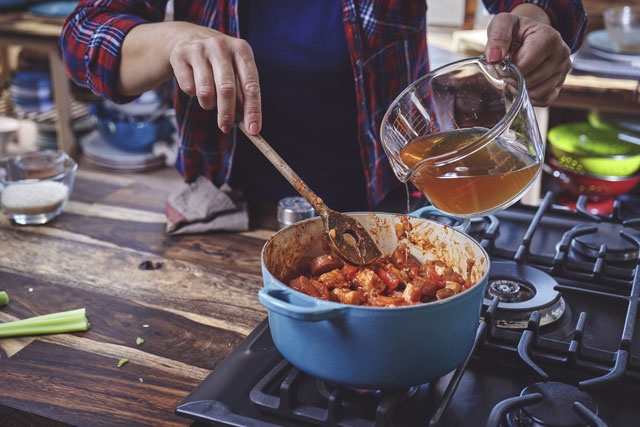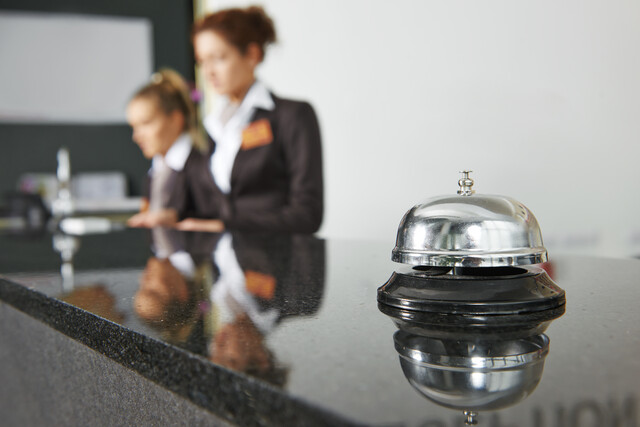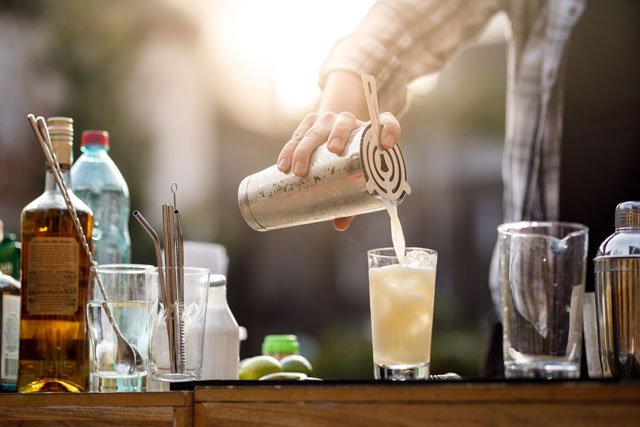Kitchen Sanitation: Dishwashing
Washing dishes seems like pretty much of a no-brainer. You do it all the time at home -- rinse the dishes, wash the dishes, dry the dishes, put the dishes away. However, like anything else in a commercial food environment, the stakes are so much higher if you do things wrong. You have probably seen this scenario before: You're sitting in a nice restaurant, and you pick up your glass of water, only to find lipstick rings all around the rim. It may make you cringe to think about who else may have sipped out of your cup, but the more frightening reality is that for every lipstick you do see, there may be millions of germs you don't see.
Hand-washing dishes
Larger facilities will have big industrial dishwashing machines, but in some smaller establishments, the dishes must be washed by hand. There are three parts to hand-washing dishes: wash, rinse, and sanitize. In order to accomplish all three, your facility must have a three-compartment dishwashing sink. Dishwashing sinks are separate from handwashing sinks, and neither one should be used for anything other than their intended purpose. In other words, don't leave a frozen chicken out to thaw inside your handwashing or dishwashing sink. Of course, no one who has completed this training would ever think of committing such an atrocity, because they would know that allowing a chicken to defrost at room temperature is a health hazard.
Sink
The sink must be clean and sanitized before beginning the washing process. The drains must be in good working order and the water must be heated to at least 110°F. Also, no one may wash their hands in a sink that is being used for dishwashing.
Wash In the first compartment, combine hot water and dish detergent. Be sure to read the manufacturer's instructions and use the appropriate amount of soap. The wash water must be at least 110°F. Use a thermometer to be sure the wash water maintains a safe temperature.
Before putting dishes in the wash water, make sure you scrape off all excess bits of food and then rinse the dishes to remove visible food particles. Make sure to replace dirty water with fresh water as needed.
Rinse
Rinse water should also be clean and kept hot. Be sure to change the rinse water frequently.
Sanitize Some facilities simply sanitize dishes with very hot water, but most add in a chemical sanitizer to water in the third washing sink. Chemical sanitizers can be made up of chlorine, iodine, or ammonium. They might come in tablet or liquid form. To determine the amount of sanitizer and required temperatures, follow the manufacturer's directions. There are required concentrations for any kind of sanitizer, to make sure the solution is strong enough to kill germs. The FDA has very specific requirements about the percentage of germs that have to be killed through the dishwashing process, so it is important to follow all package instructions and make sure to use the appropriate amount of sanitizer per quantity of water. Also, anything you wash must go through the sanitizing step, which means it must be able to be completely submerged in the sanitizing solution. If you have any utensils or dishes that are too big for your sink, they must be run through a large dishwashing machine.
Sidenote:
A recent study by the Center for Innovative Food Technologies, published in
The Journal of Food Engineering, has shown that milk residues inside of glasses and dishes provide an excellent breeding ground for bacteria, so be sure to pay special attention to glasses with those "science experiment" milk clumps on the bottom. Also, the tines of forks provide a nice, protected hiding spot for germs. Take the extra time to scrub between the tines of forks. Interestingly, the study found that although lipstick rings may be visually disturbing, lipstick holds less bacteria than many other types of residues on dishes. (Source:
http://researchnews.osu.edu/archive/dishwash.htm)
Machine Washing
There is a huge range of commercial dishwashing machines available on the market today. Check the manufacturer's operation instructions for the model you use. The big advantage commercial washing machines have over the dishwashers you might use at home is that they are amazingly fast and efficient. A commercial dishwasher combines the three stages described in the handwashing section above; it just does it all faster. Some machines have conveyor belts that run dishes through all three cycles. Others feature a hood that you pull down over a rack of dishes to clean them. The system automatically washes, rinses and sanitizes the dishes at extremely high temperatures. Some machines finish cycles in less than two minutes, saving vast amounts of time in a high-volume restaurant environment.
No matter how efficient the machine is, the operator still has to follow some basic best-practices.
Scraping
No dishwashing machine is going to remove crusted-on bits of egg or pizza cheese. The person running the washer must scrape out all the excess food from platters, plates and dishes. Usually, they scrape the big parts into the trash, and then use a high pressure wand to rinse off smaller food particles and sauces.
Stacking
Because of the way dishwashers work, it is critical to make sure water can flow freely to every dish in the rack. Don't put bowls on top of bowls, or otherwise clutter the rack so they can't get clean.
Separate
There should be two designated areas around the dishwashing area: a place for dirty dishes and a large area for clean dishes to be stored. Never put dirty dishes in the clean dish area. This invites cross-contamination and is an excellent opportunity to mistake a dirty dish for a clean one.
Clean and Maintain
Follow the manufacturer's instructions for cleaning the dishwasher and making sure the machine lines are well-maintained. Add detergent and sanitizer as needed.
Drying As long as there have been dishes, married couples have probably argued about whether it is better to allow dishes to air-dry or to wipe them dry with a towel so that they may be immediately put away. In a restaurant, dishes simply have to air-dry, and that's a good thing. Wiping down dishes with a towel actually invites cross-contamination. A towel can be contaminated with food particles or other items when you pick it up, or it can pick up germs from one of the dishes. If you use it to wipe down clean dishes, you are basically spreading that contamination across every dish it touches. Also, as the cloth becomes wet, it begins to provide an ample source of water for breeding germs.
Employee Health/Cleanliness/Hygiene
Many restaurant managers think that health, cleanliness, and hygiene just goes without saying, so they choose to say nothing about it until it becomes a problem. There are some basic principles of health and hygiene that anyone in a restaurant operation should adhere to. Not only can poor hygiene reflect poorly on your business, (making your customers wonder about the overall cleanliness of the facility and the quality of the food), it can also create an environment where germs spread easily. Every time a worker touches his hair or face, he creates an opportunity for germs to spread. If the people in the restaurant are as clean as possible, the odds are better that the food will be healthier.
Although everyone's personal habits are different, there is a serious business and health reason for managers to educate their employees about proper hygiene habits, and to follow up on their policies.
How clean is clean? At a minimum, every employee in the facility should shower or bathe at least once a day. Clothes should be clean and free of food stains and spots. Every worker should wash hands at the start of his or her shift, and several times during the shift. Hands must be washed every time you change tasks; for example, any time you change from food prep to handling trash, money, boxes, or touching animals or sneezing/coughing, it's time to wash hands. And rule number one of preventing foodborne illness is to wash hands every time you use the restroom. Signs should be clearly posted in easily visible locations to remind workers, and managers should monitor the consumption rate of soap and paper towels around the sink. (If the soap level remains the same throughout the week, no one is washing their hands.)
Hair
Nothing sets off a customer's automatic cleanliness alarm faster than stray hairs in a dish of food. Having hair fall in your food is not only unappetizing, it's unsanitary. Every time you touch your hair, germs move from your hands to your hair. Then, after you wash your hands, you may touch your hair again and pick up the same germs. Worse yet, that contaminated hair could fall into someone else's breakfast.
Every facility ought to have a "hair control" policy. In many places, employees are required to wear hats or hair nets, so that all hair is restrained. Hats also discourage people from touching their hair, which also helps prevent cross-contamination. Men should be clean-shaven or wear a face net to restrain their beards. Some people will also have to pay attention to arm hair. In these cases, gloves can help control the problem.
For servers, hair nets and hats are not required as often, but hair should be cut short or pulled back into a bun, ponytail, braid or other hair-restraining style. Untrimmed facial hair on a server is both unsanitary and visually unappealing.
Fingernails Fingernails provide a natural safe haven for bacteria. For this reason, nails should be clipped short, filed and well-maintained. Also, long nails carry the risk of breaking under the stress of work -- which could mean your nail splits into someone else's eggs. In addition to keeping your nails trimmed and filed, also pay extra attention to them when washing your hands. Use a nail brush to scrub under nails, and be sure to wash between the fingers.
Clothing As mentioned before, clothes should be clean and free of food stains and dirt. Not only does it create an unappealing image to have workers in dirty clothes, but the food stains can actually harbor bacteria that the worker could then spread around the kitchen.
The stereotypical image of a "greasy-spoon" type restaurant involves a cook with an extremely stained white t-shirt and apron. If you resemble this stereotype, change -- and change fast! Change aprons as needed, and wear chef's jackets that cover your whole upper body and are easy to change.
Every facility has different uniform requirements, so check with your organization's official policy, which should be clearly posted.
Jewelry Leave unnecessary jewelry at home. For one thing, you are less likely to lose your valuables if you leave them in your house. Secondly, bacteria can hide under rings and bracelets, making it difficult to wash effectively. Rings can also get caught up in machinery; it is possible to lose a finger because a ring got caught in a meat slicer or mixer. Loose stones or clasps could also fall into food -- and although we think it might be nice to find a diamond in our hamburger, it would not be very nice to bite into one. Such an incident could result in chipped or broken teeth, or painful internal cuts, if swallowed.
Perfumes There is no official health-code prohibition against wearing perfume in a commercial kitchen, but neither is there any good reason to do so. Deodorant is important, but perfumes can distract customers from the smell of the food. Also, many people are allergic to perfumes, which can cause both customers and workers to start sneezing, which creates another opportunity for germs to spread. Save the perfume for the days when you're off-shift.
Gloves
Many local health departments require the use of gloves in food preparation. Even if your location doesn't require them, they are still helpful in the prevention of cross-contamination. But you have to understand how to use them, and what the limits are.
Gloves are not an instant force field that protects you from all germs. You still have to follow good hygiene practices, just like you would if you were using bare hands. You have to wash hands before putting the gloves on. You have to change them or wash them whenever you change tasks. You must dispose of used gloves properly or they can cross-contaminate another food item. If anything gets under the gloves, then you must change them again.
Smoking There are so many reasons not to smoke in food prep areas. When smoking, your hands touch your lips, transferring germs between mouth and fingers. The smell of smoke also gets into the food, making everything taste smoky. Also, the ashes could accidentally fall from cigarette butt into food.
Most facilities have a designated outdoor smoking facility for employees. A growing number of restaurants prohibit smoking anywhere on the premises. Be sure you are familiar with your facility's policies, and never smoke in the kitchen or outdoors near air intake ducts.
Drinking Restaurants get hot. People working in a hot kitchen, especially in the summertime, are at an increased risk of dehydration and heat exhaustion. In order to avoid serious illness, make sure you stay hydrated, but do it with a mind toward health and hygiene.
Drink plenty of water before your shift starts so your body is well-hydrated, right from the start. Then, keep a closed container (water bottle) with you. Make sure it is appropriately labeled, so everyone can tell what the contents are, and who it belongs to. Sharpie pens work well for labeling your bottle with your initials. Keep the lid on the bottle whenever you aren't drinking out of it. When you do take sips of water, make sure not to drink directly over the food prep area. Just turn away.
Most facilities have established policies about drinking in the work area. In general, it is acceptable to use a closed container in an area away from food prep/serving areas.
The worst case situation would be drinking out of an open cup, without a straw, directly over the food prep area.
Sneezing/Coughing
Everyone sneezes from time to time. In restaurants, it is critical to understand what goes on when you sneeze: Every time you cough or sneeze, your mouth and nose are actually launching millions of microbes into the air. The germs that fly out in sneezes usually thrive in water, and are most easily transferred by hand from one place to another. Sneezing or coughing into food will contaminate it.
If you know you have a cold coming on, or if you suffer from seasonal allergies, try to get control of those symptoms before you go to work. If a sneeze sneaks up on you while you're working, move quickly away from the food prep area. Do not sneeze directly on your hands. Grab a paper towel to sneeze into, and throw it away immediately. Always wash your hands after sneezing, blowing your nose, or using the bathroom.
When to call in sick In restaurant jobs, many people are hourly-only workers or make all their money from tips. In cases like this, it can be very difficult to admit when you need to take off of work. Or, if you have a good work ethic, it might be difficult to admit that you need to take a few days to recover from an illness. You might think that you are being a "tough guy" by working through your sickness, but as a result, you could be passing an illness to many more people, some of whom could be elderly, very young, or have weak immune systems.
There are certain kinds of symptoms that should signal you to stay home. If you are a manager, watch for those symptoms in your staff, and make sure they take the time they need to recover.
Stay home if you have any of the following symptoms:
- Nonstop sneezing (droplets could transfer onto food or prep surfaces).
- Continual coughing.
- Fever.
- Nausea/vomiting.
- Diarrhea.
Animals
It would seem to go without saying that you should never allow dogs or other animals in the commercial kitchen, but it still happens. In some small, rural establishments, it isn't even unusual to see the family Labrador standing next to the restaurant grill, waiting for scraps to fall. There are just so many things wrong with this scenario that it's hard to explain them all. Fur and dander from dogs and cats can contaminate food, and their toilet habits leave much to be desired. Cats and dogs never wash their paws with soap and water, instead they lick and scratch themselves, releasing hair and spit into the air. They also like to sneeze from time to time, and have no ability to cover their mouths or sneeze into a paper towel. Lizards are famous for spreading salmonella to kitchens through their excrement. Birds shed feathers and leave droppings wherever they get the urge. Parasites can be easily transmitted this way. There is just no place for live animals in the kitchen.
The only reason live animals of any kind should be allowed to enter your establishment is if they are trained guide dogs, and then they must remain with the person they are assisting, in the dining-room area. Guide dogs are extremely well-trained, so there is a minimal risk that they will start sneezing, shaking, scratching or licking while they are inside. Except for an extreme situation, even guide dogs should not enter the kitchen.























